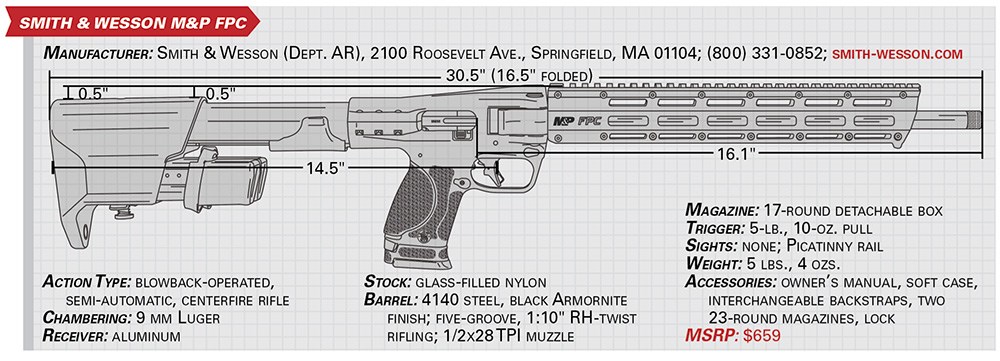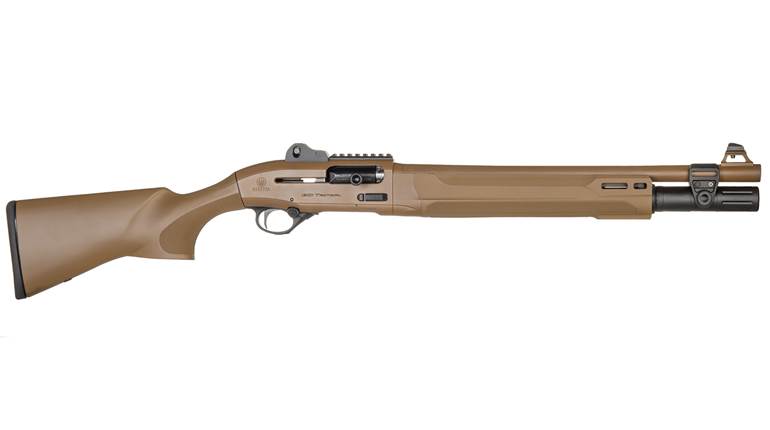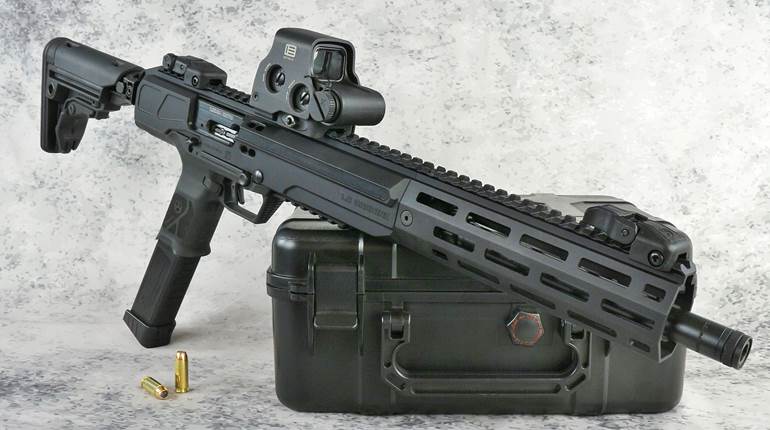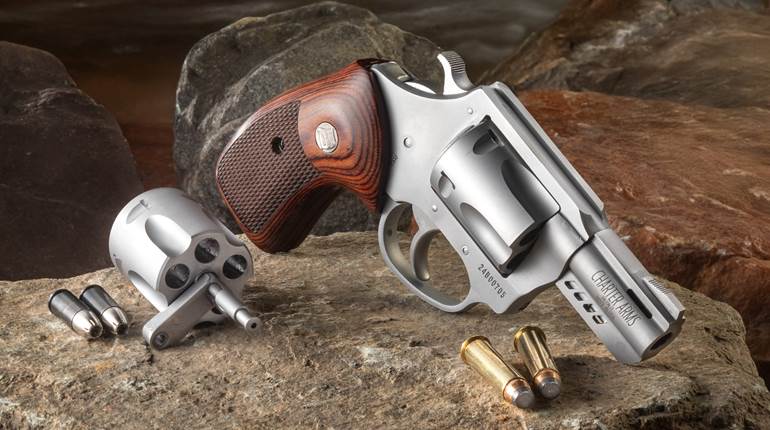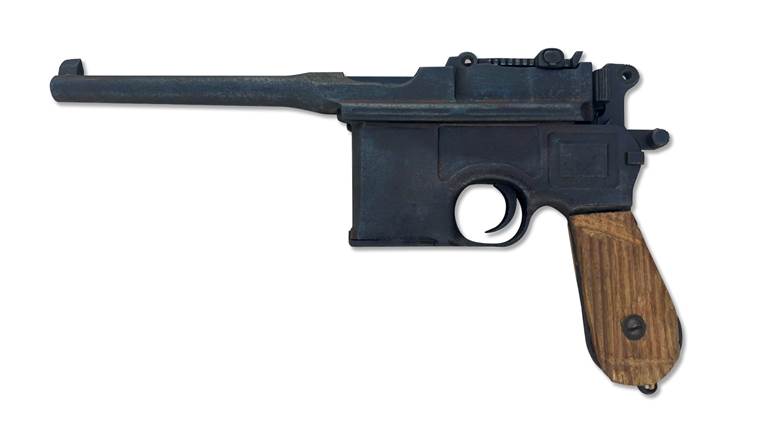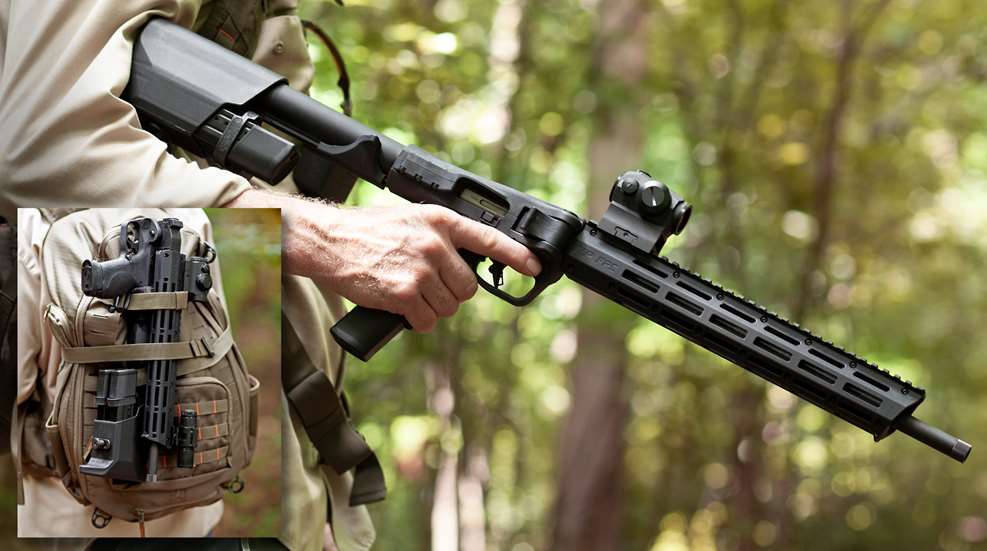
As firearm trainer Clint Smith famously noted, “The only purpose for a pistol is to fight your way back to the rifle you should have never laid down.” A shoulder-mounted firearm has an innate advantage in accuracy and controllability over one merely held in the hand. A long gun also has a ballistic advantage, even when chambered in the same cartridge as a shorter-barreled handgun. But in our modern “polite” society, it’s not easy to tote a long gun around all the time.
Gone are the days when a longrifle cradled in the crook of the arm wouldn’t draw a second glance, a Winchester lever-action could ride by your knee all day in a rifle scabbard or a shotgun was secure in the rear window rack of a pickup truck. Manufacturers have tried various methods to make long guns more compact and, thus, easier to keep close at hand. This year, Smith & Wesson threw its hat into the ring with the M&P FPC—or Folding Pistol-caliber Carbine.
The FPC marks Smith & Wesson’s first 21st century foray into the pistol-caliber-carbine world. At its heart is a blowback-operated 9 mm Luger-chambered semi-automatic action. The stainless-steel bolt and carrier ride within an aluminum tube receiver to which the polymer buttstock and grip body/receiver cover are attached.
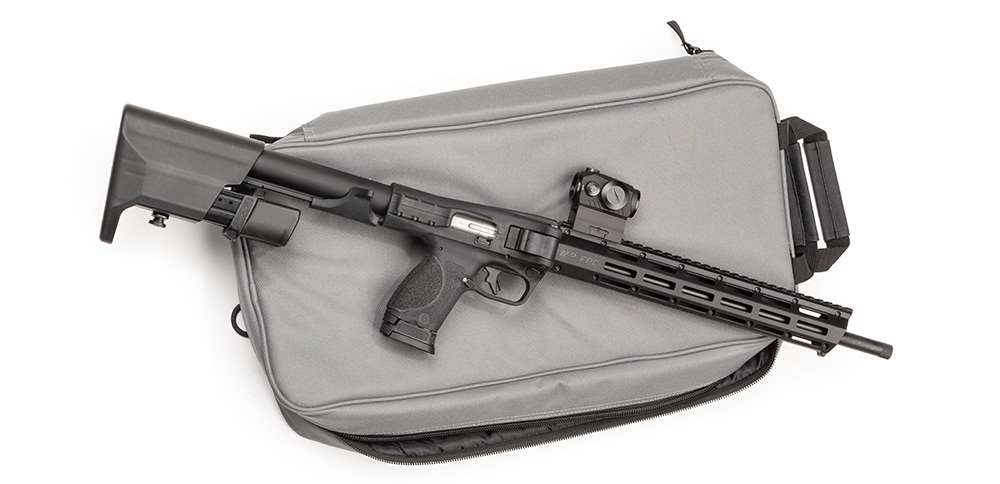
The grip has the same profile as S&W’s M&P M2.0 Compact handgun and accepts all double-column M&P 9 mm magazines of compact size and larger. The action locks open after the last round in the magazine has been fired. A 16.10" 4140-steel barrel is surrounded by a polymer handguard with an M1913 Picatinny rail on top and M-Lok slots at the 3-, 6- and 9-o’clock positions. The muzzle of the barrel is threaded 1/2x28 TPI for attaching suppressors and is supplied with a thread protector.
Smith’s use of a standard M&P pistol grip frame means that the magazine release button is reversible by simply turning a screw, and the M&P’s accessory palmswell inserts can also be used—four sizes of which are supplied. The bolt release is bilateral, located in the same position as the slide release on an M&P M2.0 pistol. Though the trigger is of the safety-bladed type offered on Performance Center handguns, the FPC also has a manual safety consisting of a simple crossbolt located above the trigger guard. The charging handle is at the rear of the action under the receiver tube, with two protruding “wings” for grasping.
Where the FPC becomes intriguing is in how it can be made compact: It hinges to fold horizontally along the length of its barrel. This is accomplished by actuating a latch on the right side above the trigger. The carbine folds easily by operating the latch with the thumb or index finger of a right-handed shooting grip and using the support hand on the fore-end to fold it to the left. The charging handle doubles as the catch when it is folded, latching into an M-Lok slot on the handguard. A chambered cartridge prevents the gun from folding.
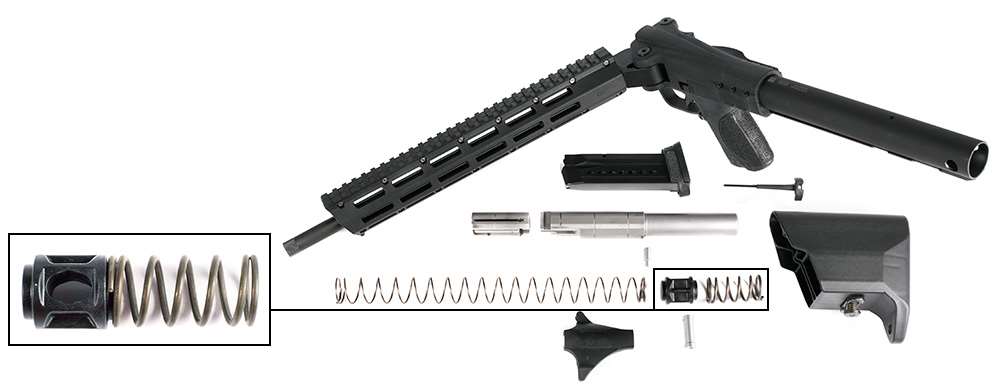
In many ways, a folding design is the ideal way to make a long gun more compact. A folding or telescoping stock is not an option available to citizens in all 50 states, and takedown designs require time and finesse to attach the two halves to each other. With a folder like the FPC, the two halves are always attached to each other and deploy into the ready position in an instant. And the advantage of folding to the side is that it allows for top-mounted optics to stay in place with the gun folded.
Another interesting feature of the FPC is the magazine storage built into its buttstock. Two additional magazines can be stored there, locked in place with a latch that interacts with the magazine’s catch slot. The magazine storage is positioned so that you can remove a spare magazine with the support hand for a reload while the gun is shouldered. The carbine is supplied with one 17-round magazine and two 23-round magazines; as the FPC’s grip is of a compact size, all three magazines use grip adapter spacers.

Unloaded with no sights and one magazine installed, the FPC weighs 5 lbs., 4 ozs. The FPC with all magazines loaded for an onboard capacity of 63 rounds, and a weapon light and SIG Romeo5 red-dot mounted, weighs in at 8 lbs., 3 ozs. Two loaded 23-round magazines in the stock give the FPC a noticeably rearward weight bias, but it still balances nicely.
To complete the M&P FPC as a low-profile package, it comes in a padded soft case. The case has a decidedly non-long-gun profile and no external pockets or PALS-style webbing. It is even made of a material that has a neutral “gray man” color. The case uses straps to hold a folded carbine securely in place with plenty of room for mounted accessories or optics and has interior pockets for holding spare magazines or other accessories. A supplied strap allows it to be carried over the shoulder or as a sling bag.
Even uncased, the FPC has a simple and minimalistic profile. There’s no muzzle device or vertical forward grip let alone a “shoulder thing that goes up.” A 15-round magazine fits flush in the grip. Though the stock looks like a telescoping design, it is fixed with a 14.5" length of pull. A state-compliant version of the FPC, with a non-threaded barrel and three 10-round magazines, is also available.
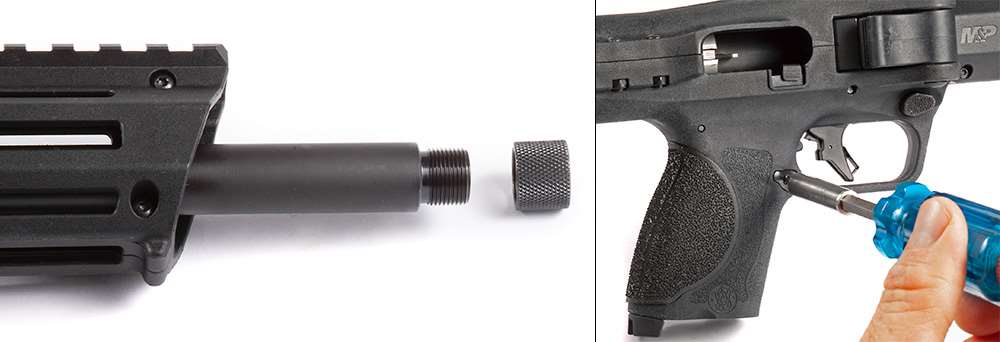
As the FPC is not supplied with sights, for formal accuracy testing I mounted a Leupold Patrol 6HD scope. The handguard’s rail was far enough rearward to provide for proper eye relief with the scope, and having the optic mounted with the barrel allowed for a repeatable zero even after folding and unfolding the gun. The straight-line design of the action requires using tall rings or an optic riser. The rail is also far enough rearward to use an AR-15-style rear aperture sight, such as a Magpul MBUS. Following bench testing, I mounted a Romeo5 for field testing.
Initially, mounting a scope on the FPC seemed like a superfluous choice, given that I was testing a blowback 9 mm carbine at 50 yards, but the rifle’s accuracy quickly proved to be up to a magnified optic. One five-shot grouping with Hornady’s American Gunner ammunition measured slightly more than 1", while the average across all three of the loads I tested was just larger than 1.5". Accuracy was aided by the FPC’s trigger. After the initial take-up, it breaks crisply at 5 lbs., 10 ozs.; overtravel is arrested by the molded-in stop, and the trigger resets to a positive click.
Over the chronograph, the FPC showcases the advantage a long gun has over a handgun of the same cartridge. Using Hornady’s American Gunner ammunition as an example, the FPC’s 16" barrel provided 22 percent more velocity and 48 percent more energy compared to the ballistics the company claims for the cartridge fired from a 4" barrel.
Except for one failure to fire early on in testing due to a light primer strike (the cartridge fired on the second try), reliability was perfect, even when using a suppressor. Smith & Wesson touts the FPC’s “integrated recoil buffer system,” which is an extra heavyweight spring positioned between the recoil spring plug and the stock; this does seem to soften the recoil that can sometimes be harsh in a blowback-operated firearm. The magazine storage in the buttstock gives it a “SOPMOD” profile, with a generous cheek weld and butt area, which also helps to mitigate the recoil impulse.
The crossbolt safety is easily disengaged with the index finger for a right-handed shooter; engaging the safety requires significantly shifting the grip or using the support hand. The bolt catch functions more as a device to manually lock the bolt to the rear, as the raised protective edge around it—and the force of the heavy bolt and spring that it is holding back—makes it difficult to activate with a shooting grip. Additionally, the right-side release is a little too close to the open ejection port and heavy bolt for comfort. Regardless, I never experienced a case of “FPC thumb” when using it.

I also found it easier to bump the charging handle to release the bolt; loading instructions in the supplied manual seem to concur with this assessment. Even with the FPC mounted to the shoulder, this was easily accomplished with a technique that would be used on an extended AR-15 charging handle. While the magazine release was difficult to reach with the thumb with the rifle mounted to the shoulder, swapping it to the other side and actuating it with the trigger finger allowed for rapid reloads with the stock-mounted magazines.
The handguard has a tiny hand stop at the end. This should be supplemented by a larger hand stop for those who use an extended “C-clamp”-type support-hand hold. I tried to mount a Magpul AFG, but, when collapsing the gun, it interfered with the buttstock and kept the FPC from folding completely. When folded, the left-side M-Lok slots and two forward 6-o’clock slots have limited use.
Fieldstripping the FPC for cleaning is simple and can be done without tools. After confirming that it is unloaded, hinging the barrel open exposes the bore to be cleaned from the chamber end. Pulling out on the stock retaining latch allows the stock to be removed. This exposes a cross pin that can be pushed out to remove the recoil spring plug and spring.
With the spring removed, the bolt assembly can be moved far enough rearward that the bolt retaining pin lines up with a slot for removal. This allows for the massive 1-lb., 10-oz., bolt and carrier assembly to slide out of the rear of the receiver, where the bolt can then be separated from the carrier. This is as far as it is recommended to disassemble for cleaning. If any of the pins prove to be stubborn, the lanyard tool stored in the grip can be used as a punch. Re-assembly is in the reverse order.

For those who already own members of the M&P handgun family, the FPC offers not only magazine compatibility, but familiar ergonomics and a similar manual of arms. Inevitable comparisons will be made to the other folding 9 mm carbine on the market, the KelTec SUB2000. The size of both rifles folded and deployed are nearly identical, with the SUB2000 coming in about a pound lighter and with an MSRP that is $80 less; the KelTec also has broader magazine compatibility. But the FPC has the advantage of its ability to fold with a top-mounted optic in place and the spare magazine-storage system.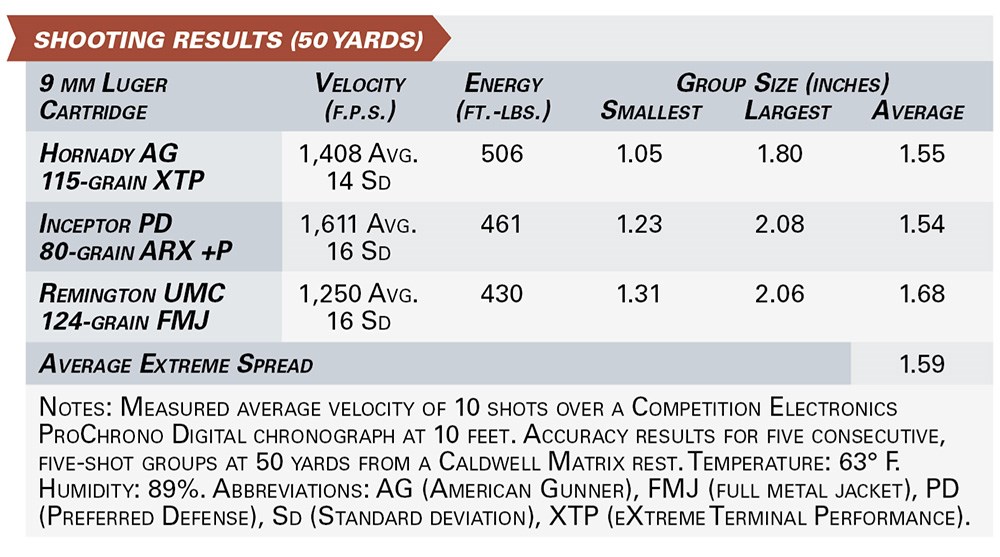
For those looking for a survival long gun to pack in a boat or airplane, the FPC offers more oomph than a .22, but is still accurate enough to make headshots on small game out to reasonable distances. As a home-defense carbine, the FPC’s compact size when folded means it can be stored and concealed closer at hand than a conventional rifle. And for those wanting to keep a long gun close at hand, the FPC, with its onboard spare magazines, makes for a grab-and-go package that can be quickly transitioned from its stored format to ready condition.
If the FPC proves to be successful, Smith & Wesson could adapt the design to other cartridges and magazines from pistols it offers, such as 30 Super Carry and 5.7x28 mm FN. One can always dream of .45 ACP and 10 mm Auto versions, but this would require a complete re-design and a larger-frame firearm. In the meantime, the FPC offers M&P familiarity in a reliable and discreet package, giving us one less excuse for not always being a “rifleman.”